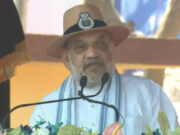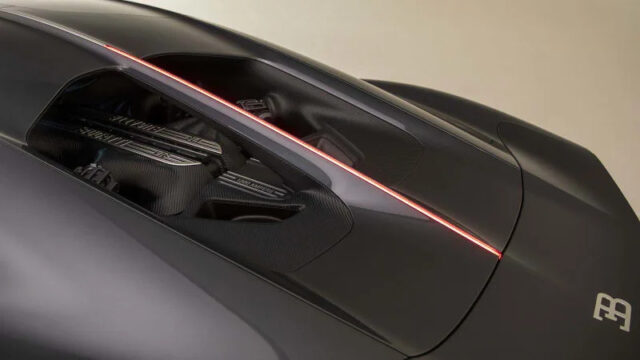LONG BEACH, Calif. — A few months ago, Bugatti invited us out to a studio in Long Beach, California, to get an early look at a prototype version of its latest creation, the Tourbillon. As the follow-up to two of the most iconic luxury-performance vehicles of the past two decades, the Tourbillon has some sizable shoes to fill, as both the Veyron and the Chiron were standard bearers of hypercar engineering during their respective eras.
The high-performance landscape has also gone through some fairly dramatic changes in the time since. While the near-1,500 horsepower produced by the Chiron’s quad-turbocharged W16 was otherworldly in 2016, it seems notably less remarkable at a point in time when there are luxury sedans capable of producing more than 1,200 horsepower and the world’s quickest production vehicle offers nearly 2,000 hp.
The paradigm shift brought on by high-performance EVs has not gone unnoticed by Bugatti, though. In 2022, the automaker formed a technical alliance with Rimac, the Croatian EV upstart that produces the world-beating Nevera. In its early stages, the partnership tasked Rimac with the development of an all-new powerplant for what would eventually become the Tourbillon, but the agreement soon evolved to effectively give Rimac founder and CEO Mate Rimac full control of the Bugatti brand through a 55/45 split with Porsche, Bugatti’s prior parent company.
This, of course, begs a question: How do you follow up an automotive icon like the Chiron with something that feels equally unprecedented when your other company has upstaged that car with its own technology? As Bugatti design director Frank Heyl explained it, you focus less on the stats and more on the experience.
“Yes, obviously it will be extremely fast. But I don’t really like to talk about the numbers. It’s more about how you feel in the driver’s seat, the sensations – the haptics of the switchgear, the smell of the leather, and the sounds and vibrations of the engine. It’s an emotional experience that can’t really be expressed in numbers.”
That experience is driven in no small part by the Tourbillon’s jaw-dropping hybrid powertrain. At the front end of the Tourbillon, there’s a dual-motor and dual-inverter setup that’s good for 600 horsepower, along with a third electric motor in the rear that delivers an additional 200 hp of its own. Matched with a 25 kilowatt battery that’s submerged in oil to maintain ideal cell temperatures and molded into the underside of the Tourbillon’s carbon fiber monocoque, Bugatti’s latest hypercar dishes out a healthy 800 horsepower sheerly through electric propulsion. It also allows the Tourbillon to go all-electric for an estimated 37 miles.
Then there’s the engine, a 64-valve, naturally aspirated 8.3-liter V16. The V is not a typo we intended to be a W. The all-new mill with the more common cylinder formation than those of its W16 predecessors delivers another 1,000 horsepower of its own without the aid of forced induction, allowing it to rev out to a soaring 9,000-rpm redline and sound absolutely incredible while doing so. Total system output is 1,800 horsepower.



“We’ve stayed true to our origins,” Heyl said in reference to the cylinder count. “I like to say that it’s the same band of 16, just regrouped in a different format.”
Four individual throttle bodies serve four cylinders apiece, and in its V configuration, the new engine required a crankshaft that’s more than 3 feet long. That would normally be a recipe for unruly NVH, but Heyl noted that Bugatti was able to smoothen things out with extensive computer simulation and materials testing. “Since you can ignite four cylinders simultaneously, the vibrations are essentially nullified by one another,” he explained. “And that allowed us to keep the (crankshaft’s) counterbalancing weights to a minimum.” Think of it as noise canceling technology for your 1,000-horsepower V16.
Heyl might not want to harp on the numbers, but there are certainly a few worth noting. Outfitted with a new eight-speed dual-clutch gearbox that sends power to all four wheels, the Tourbillon is capable of reaching 124 mph from a standstill in less than 5 seconds on its way to a top speed of 277 mph. The former figure puts the Tourbillon roughly on par with the Nevera in terms of face-melting quickness, while the latter gives it an edge of about 20 mph. It’s worth noting that the Tourbillon’s vMax stat is still shy of the Chiron Super Sport’s 304.7-mph top speed, leaving room for a potential Super Sport iteration of its own a few years down the line.


During our briefing, Heyl compared the shape of the Tourbillon to that of a falcon. While the design isn’t a massive departure from the Chiron overall, it doesn’t take much imagination to see the resemblance at the beak nose of the car.
“We like to say that beauty comes from the aesthetic of purpose, and the purpose here is performance.”
The falcon analogy mainly correlates to the Tourbillon’s reduced frontal area versus its predecessors, a change which significantly reduces aerodynamic drag. That, in turn, allows for even more rapid acceleration as wind resistance increases alongside the pace while also helping the hypercar achieve aerodynamic neutrality at top speed.
Like its predecessors, the Tourbillon eschews large screens in favor of finely crafted instrumentation and physical switchgear. To ensure that it could keep up with the manic powertrain, Bugatti turned to the medical industry for the stepper motors that move the horsepower gauge’s needle, while the use of sapphire, titanium, and crystal glass in the gauge cluster was inspired by high-end watch design. A retractable digital display does hide at the top of the center stack, but Heyl noted that all of the car’s functions are accessible without it. It’s a design ethos that’s intended to keep these cars from feeling dated decades from now, as he expects the Tourbillon to be enjoyed by owners well into the future, regardless of the next contender’s headline-grabbing stats.
“I think we’ve reached a point where cars are so incredibly fast that it’s not the differentiator anymore. It’s about the emotions that it generates. Your heart has to tell your brain that it’s a good decision to buy this car.”


































